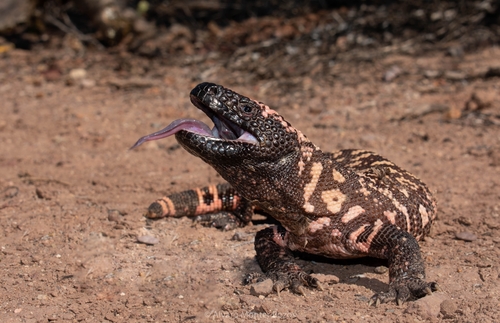
Gila Monster
The Gila monster, with its striking beaded skin of black and orange, is a rare venomous lizard. Found in deserts of the Southwest, it leads a secretive life in burrows, emerging to hunt. Its venomous bite helps control prey populations, underscoring its ecological importance.
20-30 years
Lifespan
1.3 - 2.2 kg
Weight
Brown, Grey, Black, White, Tan
Color
15 mph
Top Speed
Near Threatened
Conservation Status
Decreasing
Population Trend
Characteristics
The Gila monster, Heloderma suspectum, is a venomous lizard native to the southwestern United States and northwestern Mexico. It has a distinctive beaded skin with black and orange or yellow patterns. The Gila monster is known for its sluggish movement and spends most of its life in burrows, emerging primarily to feed on eggs and small mammals. As one of the few venomous lizards in the world, it has a unique role in controlling the population of its prey.
Distribution Range of the Gila Monster
Heloderma suspectum, commonly known as the Gila monster, is native to the southwestern United States and northwestern Mexico. Its geographical distribution includes the states of Arizona, New Mexico, California, Utah, and Nevada in the U.S., and Sonora and Sinaloa in Mexico.
Gila Monster's Habitat
Environmental Conditions
The Gila monster inhabits arid desert regions, typically found in rocky foothills and canyons. It thrives in environments with sparse vegetation, such as creosote bushes, mesquite, and cacti, which are characteristic of its native desert habitat. The climate in these areas is typically hot and dry, with extreme temperature fluctuations between day and night.
Ecological Niche
As a ground-dwelling species, the Gila monster is adapted to burrow into the ground, often utilizing burrows made by other animals. It is primarily active during the cooler parts of the day, such as early morning or late afternoon, to avoid the intense midday heat. The Gila monster is a carnivorous reptile, feeding on small mammals, birds, eggs, and occasionally carrion. Its ecological role includes controlling the population of its prey species and serving as a prey item for larger predators.
Copyright @ Nature Style Limited. All Rights Reserved.
 English
English